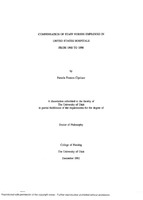Compensation of staff nurses employed in United States hospitals from 1960 to 1990
View File(s)
Visitor Statistics
Visits vs Downloads
Visitors - World Map
Top Visiting Countries
| Country | Visits |
|---|
Top Visiting Cities
| City | Visits |
|---|
Visits (last 6 months)
Downloads (last 6 months)
Popular Works for Cipriano, Pamela Frances by View
| Title | Page Views |
|---|
Popular Works for Cipriano, Pamela Frances by Download
| Title | Downloads |
|---|
View Citations
Citations
Compensation for registered nurses employed as staff nurses in nonfederal hospitals from 1960 to 1990 was studied. Significant events of hospital financing, professional efforts to improve wages and working conditions, and the changing demand for nurses were also examined. Historical method was used to gather and interpret data, construct a salary time series, and describe events affecting the interaction of supply, demand, and wages in the nurse labor market. Over thirty years, staff nurses experienced a 606% increase in actual salaries; however, when adjusted for inflation, real earnings grew only 82%. The range between minimum and maximum salaries increased from 20% to 50%, alleviating some wage compression. The cost of employer-offered benefits rose, although the hospital industry lagged behind the averages for both manufacturing and nonmanufacturing industries. Gains in nonwork compensation, such as vacation, holiday, and sick benefits, were negligible. The registered nurse labor pool grew more than threefold. Consistently two-thirds of all nurses worked in hospitals. The activity rate peaked at 80% in 1988 and continued to exceed the labor force participation for all U.S. women. Part-time work was the greatest factor affecting supply. Demand for hospital nurses also continued to rise. Expressed as vacancy rate, demand was an unreliable and probably inaccurate measure. Three-quarters of reported rates exceeded 10%, indicating shortage conditions. The hospital industry experienced frequent growth and retrenchment. Funding from the Hill Burton Act and Medicare and Medicaid created new demands for care and nurses. Federal government regulation was imposed through cost containment in the seventies and prospective payment in the eighties. Health care expenses continued to climb, and registered nurses were widely substituted for nonprofessional workers. The American Nurses Association steadfastly advocated for nurses' economic security. Salaries grew only slightly, however, and earnings never rose to a level that reduced demand for more expensive workers. Thus, the nursing profession missed opportunities to push for increases during shortages. Findings support the need for a standardized national minimum data set. The nursing profession must take bold steps to control the supply, redefine demand, and increase wages to correct the market for the nation's largest group of health care workers.
This dissertation has also been disseminated through the ProQuest Dissertations and Theses database. Dissertation/thesis number: 9307313; ProQuest document ID: 304045648. The author still retains copyright.
This item has not gone through this repository's peer-review process, but has been accepted by the indicated university or college in partial fulfillment of the requirements for the specified degree.
| Type | Dissertation |
| Acquisition | Proxy-submission |
| Review Type | None: Degree-based Submission |
| Format | Text-based Document |
| Evidence Level | Historical |
| Research Approach | Qualitative Research |
| Keywords | Nursing Salaries; Nursing Trends; Hospital Employment |
| CINAHL Subject(s) | Salaries and Fringe Benefits; Nursing Staff, Hospital; Registered Nurses; Salaries and Fringe Benefits--Trends; Nursing Staff, Hospital--Education; Registered Nurses--United States; Salaries and Fringe Benefits--Trends--United States; Nursing Staff, Hospital--Education--United States |
| Grantor | The University of Utah |
| Advisor | Princeton, Joy |
| Level | PhD |
| Year | 1992 |
All rights reserved by the author(s) and/or publisher(s) listed in this item record unless relinquished in whole or part by a rights notation or a Creative Commons License present in this item record.
All permission requests should be directed accordingly and not to the Sigma Repository.
All submitting authors or publishers have affirmed that when using material in their work where they do not own copyright, they have obtained permission of the copyright holder prior to submission and the rights holder has been acknowledged as necessary.
Related items
Showing items related by title, author, creator and subjects.
-
Factors that contribute to anticipated turnover among civilian registered nurses employed in United States Army hospitals
Huebner, Carol AnnIn this study, selected factors believed to influence anticipated turnover among civilian registered nurses employed in Army hospitals were examined. Based on a theoretical model developed from existing models of nursing ... -
Research utilization of registered nurses in United States Army Hospitals
Kenny, Deborah J.The use of research findings in clinical nursing practice has been studied extensively in civilian institutions or with civilian nurses. However, little research utilization study has been done in US military facilities. ... -
Identifying entry-level nursing practice characteristics and emerging trends in the United States through evidence-based research
Woo, Ada; Apple, Kathy; Dickison, Philip (2014-11-17)Session presented on Sunday, July 27, 2014: Identifying Entry-Level Nursing Practice Characteristics and Emerging Trends in the United States through Evidence-Based Research Preferred Presentation. Format: Oral or poster ... -
The last ten years: Nurse practitioners in the Southern United States employed in medically underserved areas
Kippenbrock, Thomas; Lo, Wen-Juo; Odell, Ellen; Buron, Bill M. (2016-03-21)Session presented on Monday, November 9, 2015 and Tuesday, November 10, 2015: Background & Significance: Collectively, the U.S. Southern states are some of the poorest, most rural, and socioeconomically deprived regions ... -
Nurses' voice: The meaning of voice to experienced registered nurses employed in a Magnet Hospital workplace
Beck, Julie A.Magnet Hospitals are healthcare environments that have recognized excellence in nursing care. These accredited Magnet Hospitals, a term coined in the early 1980’s, were seen to have the ability to attract nurses. ...





